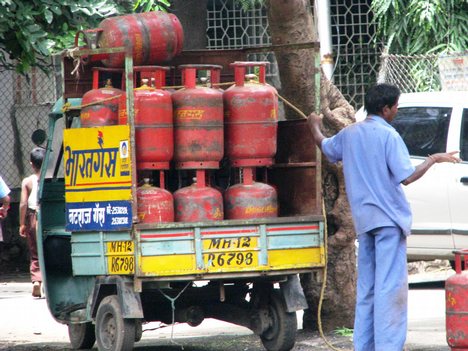
For some countrymen the gas system is also a new topic. In India there is no gas pipe system, the gas for the stove comes out of cylinders. Beside some very rare multistory buildings each flat or house has his own gas cylinders to get the cooking gas. The infrastructure of such a cylinder gas system is the cylinder, a regulator, a more or less short pipe from the cylinder to the stove and the stove or oven. Common and advisable is to
have two cylinders, because exactly if the guests are waiting for the dinner the cylinder will be empty and then it is good to just change over the second one. So far easy, but the government of India has subsidized the gas, to make cooking even without fire wood affordable for the poor. Therefore cylinders can only be ordered from three government companies, Bahrat, HP, Indian with corresponding service behavior. To avoid misuse of the gas for commercial purpose the government has allowed only one cylinder per month (13kg). This lead to the fact, that each household has a gas number and is registered at one of the providers outlet. With that number one has to call the provider in advance to order a new cylinder. In the city the cylinder will be delivered, in the outskirts one has to go to a meeting point to a given time to pick it up. If the landlord has the gas book with the registration number you have to follow the system, even more because otherwise the landlord will lose the gas registration if it is not used. The second option for a gas cylinder is to be out of that subsidized system and buy a commercial cylinder, which is approximately double the price but with less restrictions in the distribution system. Common providers are Joti Gas or Elf with a wide network of outlets, small garage type of shops as storage for cylinders and some desk for the paperwork. While buying the first fill, a deposit for the provision of the cylinder has to be paid (2010 – 2000INR), the regulator will be provided and the service team will fix the cylinder to the gas system or the stove directly with some rubber hose pipe. The whole procedure can be finished in half a day, depending on the service team’s schedule. Later the refilled cylinders will be delivered or can be picked up. The gas price is varying, driven by the world gas price.
To maintain the gas system you have to take care that the cylinders are refilled. To exchange you close the regulator, disconnect the regulator, exchange the cylinder with the spare one and fix the regulator again. The rubber hose pipe needs to be exchanged every year to avoid brittleness and leakage. The stove needs to be clean, especially the gas outlets. If you smell gas during your stay first close the valve of your gas system, close the regulator valve, open the windows and do not switch on electrical items like lights. Then call the expert to check the system. Here it is good to have the telephone number collected in the beginning of your tenancy. To minimize the risk very often you find the cylinders stored outside and if you close the regulator valve, the house is safe.
 |
| gas cylinder delivery |
 |
| gas cylinder pick up point |
 |
| gas cylinder compartment outside of house, inside subsidized cylinder outside commercial, visible regulator as connection to house pipe with main closing valve |
 |
| connection from house pipe to cooking range with rubber hose pipe and closing valve |





No comments:
Post a Comment